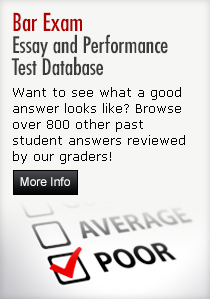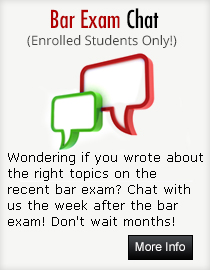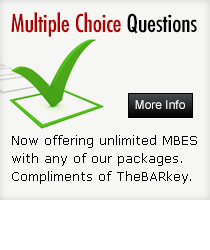Performance Test 101
ABOUT THE TEST
During each test, each student must complete one performance tests (PT). During a California Bar Exam session, the PT is administered to a bar exam candidate on one day during a 1 1/2 hour session. Each question consists of a file and library along with task instructions (usually through a memorandum) providing instructions to the applicant with a task which must be performed.
According to the California Bar Examiners, a Bar Grader is looking for the following:
- A candidate's ability to demonstrate his or her ability to understand and apply legal authorities in the context of a factual problem.
- A candidate's specific response to the problem presented to them through the manner proscribed.
The California Bar Examiners have suggested that a student should be able to do the following:
- Review the facts provided in the file and determine which facts are important.
- Analyze the legal authorities and principles applicable to the present situation and formulate legal theories using the facts presented.
- Recognize and help resolve any ethical issues which a student may find in the question.
- Apply a student's problem solving skills to help resolve the present problem and also provide alternatives.
- Properly and efficiently communicate their solution to the problem
The Bar Examiners have approximately 150 experienced attorneys grade each bar exam cycle. Most of the graders have been grading for the exam for at least five years. The graders are divided into 8 groups which consist of 11 experienced graders and up to 3 apprentice graders to grade the PTs. The groups meet 3 times prior to each exam for purpose of calibration. The Committee uses a unique grading procedure created to ensure a consistent pass rate each year. On the written section of the examination, applicants are graded initially on a basis of 400 possible points for two performance exams (each worth 200 points).
PREPARATION FOR THE TEST
It is eight weeks before the bar exam. You have registered for the exam, begun your bar review course, and made your hotel reservations. Are you ready for the performance tests? With our guidance, we will try and make it an easy process.
PAPER CLIPS, HIGHLIGHTERS, AND OTHER GOODIES
There are special unique items which bar exam candidates should bring specifically for the performance tests. These are items are allowed for the performance tests by the bar examiners. The full list can be found in your instruction booklet provided for you once you've signed up for the exam. However, there are a few items we would like to highly recommend:
(1) Colored Paper Clips (at least 50): Many students don't realize how easy a paper clip can help their test taking experience. Pick out a few colors and use them! You should use them to help identify key areas in your booklets. For example, you could use yellow paper clips to identify key facts in your file or a significant rule of law in your library!
(2) Highlighters (at least 5 colors): A highlighter is also a very helpful tool for the performance tests. You should try and bring at least five bright colors. You can use them on different areas of the test. For example, you could use a pink highlighter to identify the specific task in the task memorandum by the lead attorney or highlight key counter arguments to your point!
(3) Miniature Clock (not digital!): Yes, a clock. Not a watch. A clock is crucial to your test taking experience. It is nice that the bar examiners have approved this handy device. You can purchase a clock approved by the bar examiners at your local drugstore and they can be purchased for under $10. Place the clock at the corner of your desk. Now, you can use the clock to anchor you with different sections of the exam. For example, the clock can help remind you that it is time to read the library or start typing your answer. Time organization is key to doing well on this test!
(4) Ear Plugs: You may not realize it now but I'm sure you recall how loud your classroom was during exams. Now multiply that by 1,000. Oh yeah, and add some loud bathroom doors! You get the point. Ear plugs are key to staying focused on this exam. Try and visit your local drugstore and purchase some premium ear plugs (they usually come in a bright orange or blue color) and cost under $10. Don't waste your money on the type that you can squeeze with two fingers! The firmer, the better!
TAKING THE TEST
Did you know there are several approaches to taking a performance test? Some believe you can't practice for the test. Others believe you can practice and prepare approaches too! Here at Bar Exam Doctor we believe the latter.
APPROACHES
(1) File First, Then Library: The first approach is to read the file first and then the library. This requires a student to trust in themselves. What do we mean by this? Many students read the file first and then become nervous that they don't know the law so they read it slowly and make an extremely long outline. This is not necessary and can hurt your performance. The California Bar Examiners know what they are doing. This method works for some students but not for most. Certain facts will become repetitive and essentially jump out at you over and over. These are usually the key facts. Once they are jotted down, a student can move to the library and apply to them to the law. (Free Download: Performance Test Approach)
(2) Library First, Then File: This second approach is generally more favorable to students. Students prefer this method over the former because a student feels more comfortable reading the law first. Even though this method is preferred by students more, it is actually similar to the first method. There is usually a test that will be repeated throughout the cases or statutes. The tests usually (not always the case) are used for the student's analysis. Some students think that because a test is in their library that it should be jotted down immediately. Be cautious when identifying a test. Sometimes, only certain elements are needed for a student's analysis!
ORGANIZATION
(1) Materials: Organization is key to doing well on this test. Organization is both important for physical items on your desk as it is for words on your screen! Students often become over anxious and throw everything in a pile once the books are handed out. Try not to do this. While the proctors are counting students and getting ready to hand out books, place your items neatly around you. For example, you may want to place your clock at the corner of your desk and the paper clips and highlighters to your right. Placement is key to keeping you focused during the test. The last thing you want to worry about is finding your green highlighter!
(2) Outline: I'm sure you know from your essay preparation that outlines are like gold for the performance test! Students don't realize how important an outline is for the performance test. Whether you read the file or library first, the key issue is to read your task memorandum first! Read it, read it, read it! We can't stress enough how important it is. It usually tells you enough to get you started. For example, it usually tells you the tone, the type of task, the value of each section, and questions presented. Once you've outlined your task memo either on your computer or paper then you can begin filling in the blanks with the file and library. Remember, no points are given for your outline, so make sure everything gets onto your answer!
(3) Answer: The answer is the most important document of this exam. I'm sure you know why! Without the document, you can't pass the test! Students often forget how important a clean and concise answer is on the performance test.
Headings: Headings are essential to a passing score on the performance test. The bar examiners usually provide you with a sample header for pleadings. This shouldn't be the first time you see this! Headings should always be complete. Meaning that they should apply the facts and law and support your argument. Don't just repeat the law! Also, try and either write them in caps or underline them. Roman numerals are not necessary.
Spacing: Students don't realize how much spacing helps a student's answer. Remember, you want your answer to look clean and concise! For example, space your headings the same throughout your entire answer. Make the document look as real as possible!
Spelling: Many students hate to spell check their answer! Have you ever read a good answer and then found several typos? It doesn't look so good. Try and allocate five minutes before you're done with the exam and read your answer top to bottom. It all helps!
(4) Time allocation: There are several theories for allocating the proper amount of time for each step of writing a good performance test. At Bar Exam Doctor, we believe our students should allocate approximately 15 minutes to reviewing the task memo and separating their materials accordingly. The next 30 minutes should be allocated to outlining and reading through the library and then the file (or vice versa). The next 30 minutes should be spent writing the performance test. Because the answer is so important - take your time. Do a good job outlining the file and library so you don't have to go back and cherry pick! The last 15 minutes should be spent reading over your answer. Check your spelling, spacing, headings, etc! Would you feel confident submitting this to a judge? The answer should be yes!
AFTER THE TEST
Relax! Please? It's over. The hard work is done. You have done everything possible. Don't second guess your work. Everything will work out. Now, go take a swim at the beach or go see that movie you've been waiting to see!
*All information about the grading process has been taken directly from the California Bar Examiners website.
Testimonials
"This was my third attempt at the California Bar and thanks to Bar Exam Doctor I passed!! I am extremely grateful for all the helpful tips which helped me pass the essay portion of the exam. Thank you!!!.
Reema R., Esq.
"I passed--in part due to your graders detailed comments. Your service was definitely worth my time and money. I have already recommended you to several people from my school. Thanks again."
Michael L., Esq.
"I recommend the Bar Exam Doctor if you need to drastically improve your scores. I went from mid 50s on my essays and PTs to passing the the Bar Exam after using their service."
Reuben A., Esq.
"I finally passed!"The Bar Exam Doctor graders gave me more extensive and helpful feedback on my essays and PTs than I received at any other bar review, including Barbri and Barwinners!











